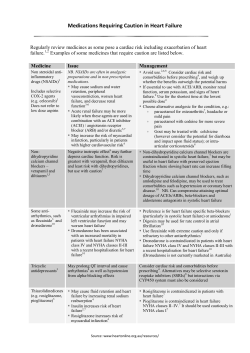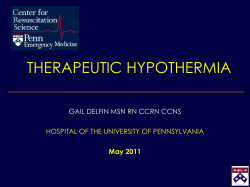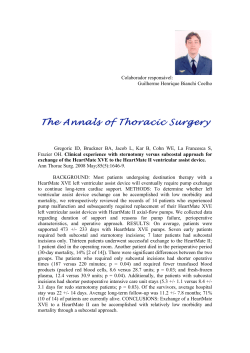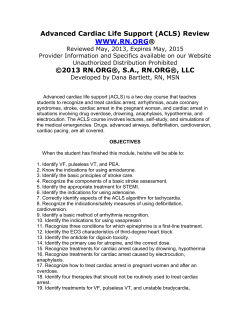
A / PROF JULIE MCMULLEN CARDIAC HYPERTROPHY CELL SIGNALLING & METABOLISM
CELL SIGNALLING & METABOLISM KEY FACTS A / PROF JULIE MCMULLEN Team Researchers: 5 Students: 4 Postdoc fellows: 3 CARDIAC HYPERTROPHY Translation Patents: 1 Links USA, Japan Keywords Cardiac hypertrophy Heart failure Atrial fibrillation Signalling Bio-resources Genetic mouse models Adeno-associated virus The goal of our laboratory is to develop better treatment strategies for patients with heart failure and atrial fibrillation by studying molecular mechanisms in genetic mouse models and cell culture. Research Brief Our research is focused on identifying genes/proteins that mimic the protective effects of exercise. Growth of the heart (also termed cardiac hypertrophy) can be induced by physiological stimuli (e.g. chronic exercise training) or pathological stimuli (e.g. high blood pressure). Physiological hypertrophy (“good” heart growth) is characterised by normal or enhanced heart function; whereas pathological hypertrophy (“bad” heart growth) is associated with cardiac dysfunction, and increased morbidity and mortality. Our laboratory are examining the possibility of activating “good” genes and signalling pathways that may normally be activated during the induction of physiological hypertrophy e.g. in the “athlete’s heart”. We previously reported that the insulin-like growth factor 1 (IGF-1)-phosphoinositide 3kinase (PI3K) pathway plays a critical role for the induction of exercise induced heart growth. Thus, activation of PI3K, or targeting novel regulators of this pathway (e.g. genes, proteins and microRNAs), represents a new strategy to treat heart failure. Methodologies • • • • Cardiac function studies (echocardiography, electrocardiography) in genetically modified mouse models In vivo delivery of AAV In vivo delivery of agents that inhibit microRNA qRT-PCR, Northerns, Westerns, immunoprecipitation, kinase assays, cell culture Selected Publications CONTACT Julie McMullen +61 (3) 8532 1194 julie.mcmullen@ bakeridi.edu.au • Bernardo BC, Gao XM, Winbanks CE, Boey EJ, Tham YK, Kiriazis H, Gregorevic P, Obad S, Kauppinen S, Du XJ, Lin RC, McMullen JR*. Therapeutic inhibition of the miR-34 family attenuates pathological cardiac remodeling and improves heart function. Proc Natl Acad Sci USA. 109:1761520, 2012. • Weeks KL, Gao X, Du XJ, Boey EJ, Matsumoto A, Bernardo BC, Kiriazis H, Cemerlang N, Tan JW, Tham YK, Franke TF, Qian H, Bogoyevitch MA, Woodcock EA, Febbraio MA, Gregorevic P, McMullen JR. PI3K(p110α) Is a Master Regulator of Exercise-Induced Cardioprotection and PI3K Gene Therapy Rescues Cardiac Dysfunction. Circ Heart Fail. 5:523-534, 2012. • Lin RC, Weeks KL, Gao XM, Williams RB, Bernardo BC, Kiriazis H, Matthews VB, Woodcock EA, Bouwman RD, Mollica JP, Speirs HJ, Dawes IW, Daly RJ, Shioi T, Izumo S, Febbraio MA, Du XJ, McMullen JR. PI3K(p110α) protects against myocardial infarction-induced heart failure: Identification of PI3K-regulated miRNAs and mRNAs Arterioscler Thromb Vasc Biol 30: 724-32, 2010. • Pretorius L, Du XJ, Woodcock EA, Kiriazis H, Lin RCY, Marasco S, Medcalf RL, Ming Z, Head GA, Tan J, Cemerlang N, Sadoshima J, Shioi T, Izumo S, Dart AM, Jennings GL, McMullen JR. Reduced PI3K(p110α) increases the susceptibility to atrial fibrillation. The American Journal of Pathology 175:998-1009, 2009. • McMullen JR, Amirahmadi F,Woodcock EA, Schinke-Braun M, Bouwman RD, Hewitt KA, Mollica JP, Zhang L, Zhang Y, Shioi T, Buerger A, Izumo S, Jay PY and Jennings GL. Protective effects of exercise and PI3K(p110α) signaling in dilated and hypertrophic cardiomyopathy. Proc Natl Acad Sci USA 104: 612-617, 2007. BAKER IDI HEART & DIABETES INSTITUTE CELL SIGNALLING & METABOLISM Identifying new therapies based on differences in physiological & pathological heart growth PI3K gene therapy improves function of the failing heart Single administration of adeno-associated viral vector (rAAV6) containing PI3K improves heart function (fractional Inhibition of PI3K-regulated microRNAs can improve heart function AntimiR was delivered to mice with pre-existing cardiac dysfunction due to pressure overload (TAC). Heart function (fractional shortening) improved in antimiR treated mice but not control. Heart size and atrial size were lower in antimiR-treated mice. BAKER IDI HEART & DIABETES INSTITUTE
© Copyright 2025





















